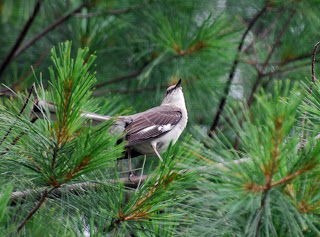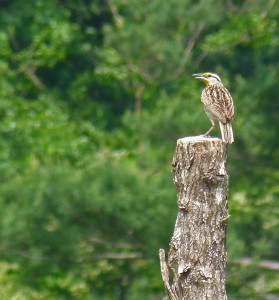It is not uncommon to see a group of crows or mockingbirds chasing a hawk or eagle, or a group of songbirds fluttering and calling around a perched owl. Such “mobbing” behavior is probably the most frequently observed overt antipredator strategy among birds. A predator may be mobbed regardless of whether it is in flight, on the ground or in vegetation. Birds attacking a perched or ground predator always give loud alarm calls and may make physical contact. Flying birds of prey are attacked by swooping down at a steep angle from above and behind, and emitting alarm calls. Sometimes contact is made with bill or feet. Nevertheless, the exact purpose of such noisy group demonstrations remains a matter of some debate.
Mobbing behavior has many functions. The most obvious would be to protect the young in the nest during the nesting season. Other times of the year smaller birds can simply move away from an invading predator, but in the spring, most birds have set up a territory and they are obliged to defend it. Predators often rely on surprise to succeed. When a predator is discovered, birds will blow its cover by the loud alarm calls. This will alert other birds to the presence of a predator, and reduce its chances of success.
Careful experiments have shown that birds can learn from each other which predators to mob (indeed, one bird in an experiment was taught by another to “mob” a many-colored plastic bottle, although the mobbing was halfhearted). Therefore one function of mobbing may be educational — to teach young birds the identity of the enemy. Another may be to alert other birds to the presence of the predator, either getting them to join in the mobbing or protecting them, since a predator is unlikely to be able to sneak up on an alert victim. The original mobber may benefit directly by the predator being moved along or indirectly if the protected birds are its kin.
It is not clear why predators don’t simply turn on their tormentors and snatch up one or two of the mobbing birds. If they did, presumably mobbing would quickly disappear; that it persists suggests that surprise is an essential element in raptor hunting. One theory proposes that hawks become used to it and harassment simply becomes part of their life. It is going to happen no matter what, so they might as well try not to fight it. Also, there is little reason for the hawks to fly away because they are bound to end up in some other bird’s territory and will have to listen to those new birds scream in their face. Large hawks are rarely quick enough to actually catch a small bird. Seldom do we see birds mobbing the smaller, quicker hawks. Small hawks can easily catch songbirds and would love to have the little birds visit them for lunch. So the small hawks are wisely avoided by most birds. The birds, instead, turn their attention to the less threatening larger hawks.
Last summer a Red-Tailed Hawk we called Adell was released at the Nature Preserve by Raptor Rehabilitation of Kentucky, Inc. As soon as she flew up into a tree, the mockingbirds immediately arrived loudly proclaiming the presence of a new predator. She was only a young hawk, and probably not a very good hunter at the time, but the mockingbirds didn’t give her much of a chance.
The good news is that Adell is still at the Preserve. We have seen her flying around several times in the last few weeks. You can recognize her by the deep rusty color of her breast, which is rather unusual for Red-Tailed Hawks. Next time you see a hawk circling around or perched in a tree, look to see if it’s Adell!







